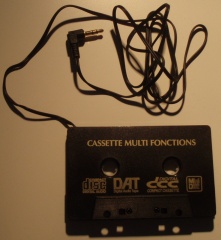Today I'll write again about CPC464, this time, about the cassettes.

Not long ago (before the cold) I was with my wife at some store, where I found a particular item (see the photo on the right) - an audio cassette that in fact was an adapter between any device that one can plug a jack into, and a cassette recorder (a cassette player). If someone hasn't seen such an adapter, let me explain: the cassette has a jack-ended cable sticking out of it, one plugs the jack connector into some audio-outputting device (an mp3 player, a diskman, a soundcard, whatever), and inserts the cassette to a cassette player. The cassette has a writing head (or a similar part) in the place where a normal cassette has the tape that is read by the reading head of the cassette player - this way, the writing head writes the audio that comes through the jack-cable to the reading head of the device. Cute, simple, and it works very well.
 The moment I saw the invention, it became obvious to me why was it invented - it was made to put it in the CPC464 and plug it into the PC, and send data through the sound card!
The moment I saw the invention, it became obvious to me why was it invented - it was made to put it in the CPC464 and plug it into the PC, and send data through the sound card!Well, as I learned after I came back to my home, I wasn't the only one who figured that appliance. In fact, it seems to be a very common procedure (I've seen at least a few pages with this method of data transfer described).
The whole thing works like this. You insert the device to the CPC464, plug it into the PC, enter RUN" on the CPC464, hit PLAY on the cassette recorder, and PLAY on the PC - where you have a game/program (let's not cheat ourself, we want to run a game, not some program) as WAV/MP3/FLAC put some audio player. And this works (tested).
Honestly I thought that acquiring games in audio format would be hard, but it's not. Actually, you do not look for games in WAV/MP3/whatever, but for cassette images (CDT/TZX/TAP/CSW/PZX/etc). These images can be easily converted into WAV files, using for example Tape2WAV v1.8 by Mark "Woody" Woodmass (I couldn't find the authors page, but the app can be downloaded here).
The above experience set me on a straight path to learning a few more things about compact cassettes.
By the way...
If want to improve your binary file and protocol skills, check out the workshop I'll be running between April and June → Mastering Binary Files and Protocols: The Complete Journey
First of all, the data on the CPC464 cassette is written in a simple manner - a high value (value is not tone, this has nothing to do with tone) is 1, a low value is 0, and the frequency is 500 Hz. Now, one can calculate that 500 Hz means 500 bits per second, which gives a terrifying speed of 62,5 bytes per second. But it's not pure data, there are some other things there like synchronizing track, or a pilot track and a terminating track (the technical details about this is available at cpcwiki.com). It's easy to calculate that the load time of a 64kb game is about 15 minutes ;D
However, most of the games had only the first packet (the data was organized in 2Kb packets) codded this way. The packet contained a loader, that could load the rest of the data, that was compressed in some manner. Thanks to this, a 64KB game would load only 8 minutes.
And thats all for now. I'm currently working (In my spare time) on a method that would allow sending BASIC programs from a PC to the CPC464 (using the above invention), but no results just yet.
P.S. Xa said that my layout sucks, and he's making me a new one. So expect a layout change in a few days or so ;>









Add a comment: